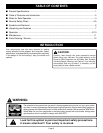
Page 6
ELECTRICAL
SYMBOLS
SYMBOL NAME DESIGNATION/EXPLANATION
V Volts Voltage
A Amperes Current
Hz Hertz Frequency (cycles per second)
W Watt Power
min Minutes Time
Alternating Current Type or a characteristic of current
n
0
No Load Speed Strokes, at no load
Designates Double Insulated
Construction tools
Revolutions, strokes, surface speed,
orbits etc. per minute
Indicates danger, warning or caution.
It means attention!!! Your safety is
involved.
Important: Some of the following symbols may be used on your tool. Please study them and learn their meaning.
Proper interpretation of these symbols will allow you to operate the tool better and safer.
Safety Alert Symbol
Revolutions or Reciprocation Per Minute
Class II Construction
.../min
ELECTRICAL CONNECTION
Your saw has a precision built electric motor. It should be
connected to a power supply that is 120 volts, 60Hz, AC
only (normal household current). Do not operate this tool
on direct current (DC). A substantial voltage drop will cause
a loss of power and the motor will over heat. If your tool does
not operate when plugged into an outlet, double-check the
power supply.
EXTENSION CORDS
When using a power tool at a considerable distance from the
power source, use an extension cord heavy enough to carry
the current that the tool will draw. An undersized extension
cord will cause a drop in line voltage, resulting in a loss of
power and causing the motor to overheat. Use the chart
provided below to determine the minimum wire size required
in an extension cord. Only round jacketed cords listed by
Underwriter's Laboratories (UL) should be used.
Length of Extension Cord Wire Size (A.W.G.)
Up to 25 16
26 to 50 14
51 to 100 12
When working with the tool outdoors, use an extension cord
that is designed for outside use. This is indicated by the
letters WA on the cord's jacket.
Before using an extension cord, inspect it for loose or
exposed wires and cut or worn insulation.
CAUTION:
Keep the cord away from the work area and position the
cord so that it may not get caught on materials or other
objects during cutting.














